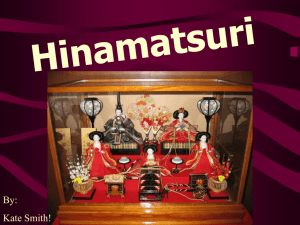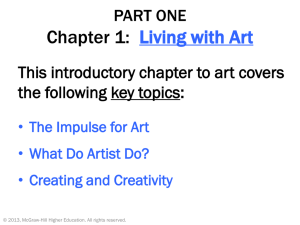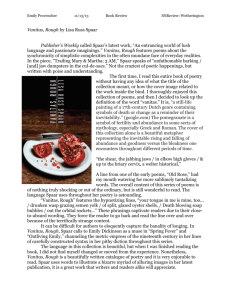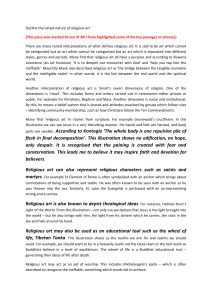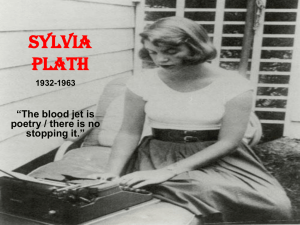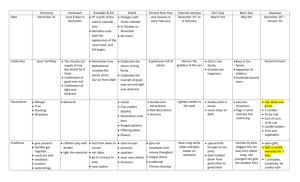Paperdoll Essay
advertisement
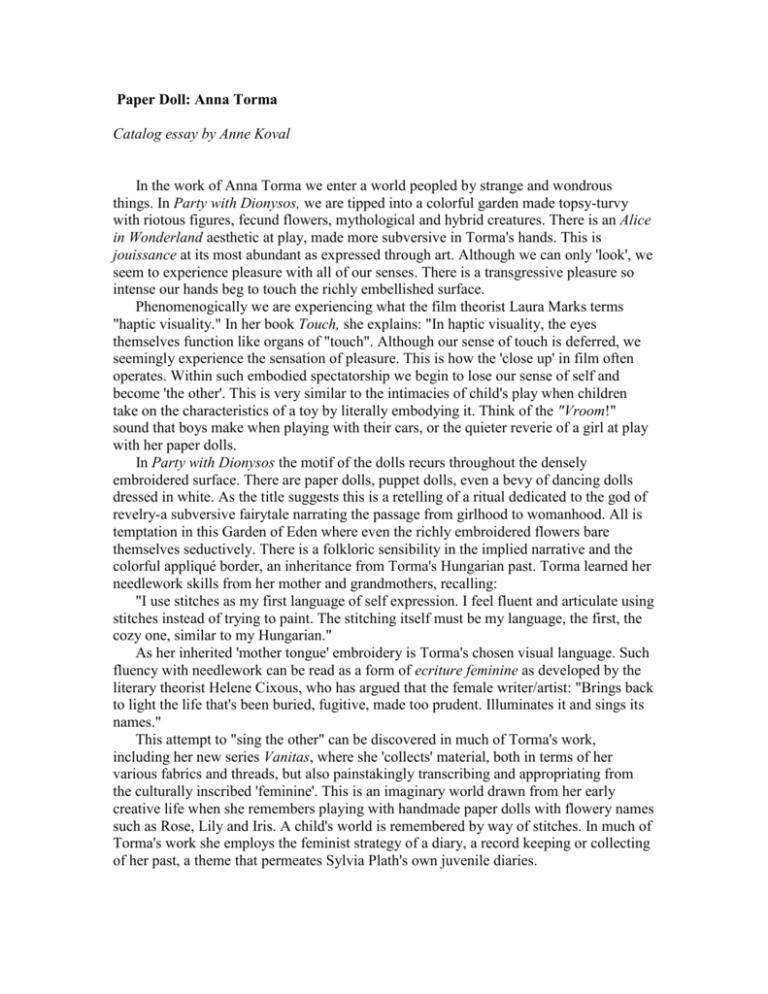
Paper Doll: Anna Torma Catalog essay by Anne Koval In the work of Anna Torma we enter a world peopled by strange and wondrous things. In Party with Dionysos, we are tipped into a colorful garden made topsy-turvy with riotous figures, fecund flowers, mythological and hybrid creatures. There is an Alice in Wonderland aesthetic at play, made more subversive in Torma's hands. This is jouissance at its most abundant as expressed through art. Although we can only 'look', we seem to experience pleasure with all of our senses. There is a transgressive pleasure so intense our hands beg to touch the richly embellished surface. Phenomenogically we are experiencing what the film theorist Laura Marks terms "haptic visuality." In her book Touch, she explains: "In haptic visuality, the eyes themselves function like organs of "touch". Although our sense of touch is deferred, we seemingly experience the sensation of pleasure. This is how the 'close up' in film often operates. Within such embodied spectatorship we begin to lose our sense of self and become 'the other'. This is very similar to the intimacies of child's play when children take on the characteristics of a toy by literally embodying it. Think of the "Vroom!" sound that boys make when playing with their cars, or the quieter reverie of a girl at play with her paper dolls. In Party with Dionysos the motif of the dolls recurs throughout the densely embroidered surface. There are paper dolls, puppet dolls, even a bevy of dancing dolls dressed in white. As the title suggests this is a retelling of a ritual dedicated to the god of revelry-a subversive fairytale narrating the passage from girlhood to womanhood. All is temptation in this Garden of Eden where even the richly embroidered flowers bare themselves seductively. There is a folkloric sensibility in the implied narrative and the colorful appliqué border, an inheritance from Torma's Hungarian past. Torma learned her needlework skills from her mother and grandmothers, recalling: "I use stitches as my first language of self expression. I feel fluent and articulate using stitches instead of trying to paint. The stitching itself must be my language, the first, the cozy one, similar to my Hungarian." As her inherited 'mother tongue' embroidery is Torma's chosen visual language. Such fluency with needlework can be read as a form of ecriture feminine as developed by the literary theorist Helene Cixous, who has argued that the female writer/artist: "Brings back to light the life that's been buried, fugitive, made too prudent. Illuminates it and sings its names." This attempt to "sing the other" can be discovered in much of Torma's work, including her new series Vanitas, where she 'collects' material, both in terms of her various fabrics and threads, but also painstakingly transcribing and appropriating from the culturally inscribed 'feminine'. This is an imaginary world drawn from her early creative life when she remembers playing with handmade paper dolls with flowery names such as Rose, Lily and Iris. A child's world is remembered by way of stitches. In much of Torma's work she employs the feminist strategy of a diary, a record keeping or collecting of her past, a theme that permeates Sylvia Plath's own juvenile diaries. In Vanitas I, objects associated with personal vanity, particularly those pertaining to the world of fashion, are shown in minute detail. The silk backing with its fleshy colour suggest old lingerie from the past. We are drawn into the narratives as we decipher the various codes of fashion, from comic book villains to elegant fashion plates. Torma employs her needlework as the subject requires-more crudely in her childlike recollections, or with great skill as she appropriates from magazine illustrations. She deliberately mixes her metaphors with multiple narratives, a layering of memory. As a young art student in Budapest in the 1970s Torma first read Sylvia Plath's The Bell Jar. She recalls " the voice of the book matched with my melancholy and helped me to question the meaning of life, art and womanhood." This questioning tone is the subject of Vanitas II with its associations with Dutch seventeenth- century still life painting. These paintings were abundant in the symbolism associated with the vanitas and alluded to the transience of our material life compared to our spiritual existence. In Torma's Vanitas II the skull operates as memento mori; a reminder of our own mortality. A meticulously embroidered anatomical figure serves as an index for the body, while the "skin" of the silk backing acts as another memento mori-a reminder of our human frailty. The artist further layers memory into the work by recording her family history using fabric transfers of old photographs to document their stories. The sense of the nostalgic is pervasive here. As a vanitas, we are reminded of our own histories, our own mortality. Between these two works by Torma we measure life and its luxuries against death. Group exhibition with Barb Hunt, Ed Pien, Sylvia Plath, Cindy Sherman, Jeanie Thib, Anna Torma, Lynne Yamamoto, Cybele Young Owens Art Gallery, 16 September to 6 November 2011 Mendel Art Gallery, 30 March to 10 June 2012 Curated by Anne Koval, she is a poet and writer teaching in the Fine Art Department at Mount Allison University as Associate Professor in Art History.
